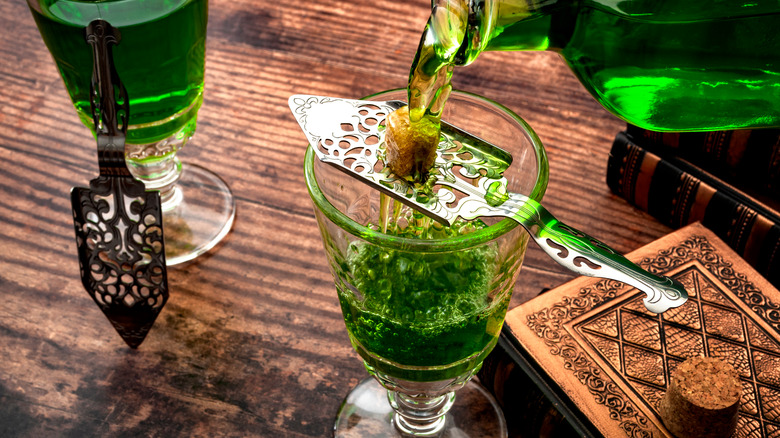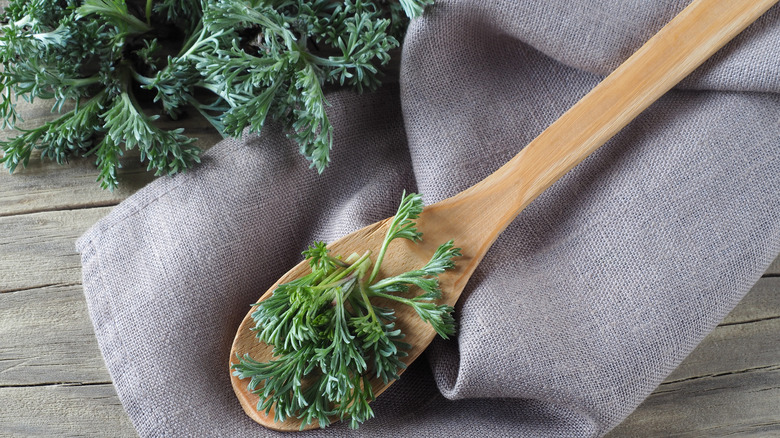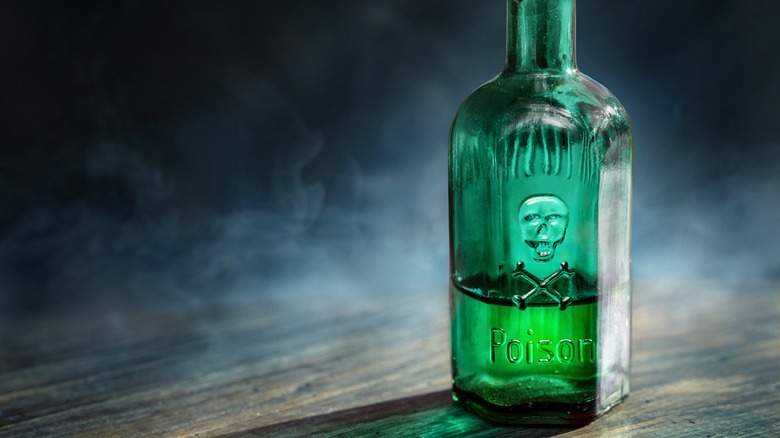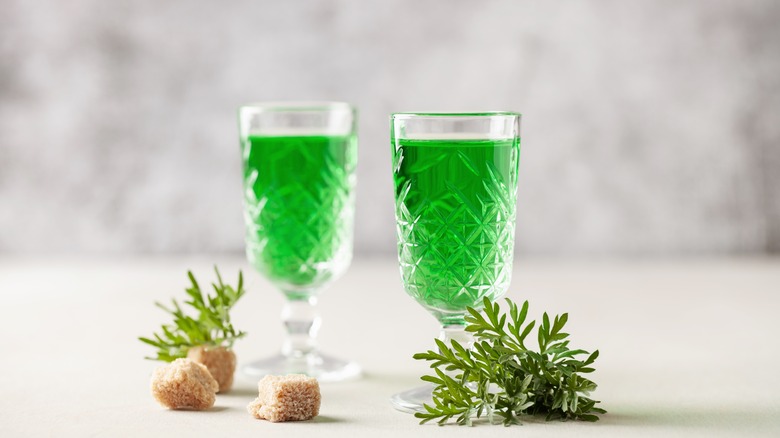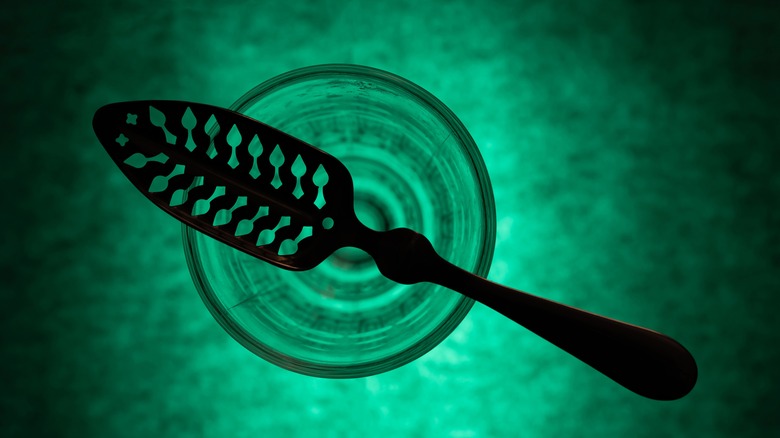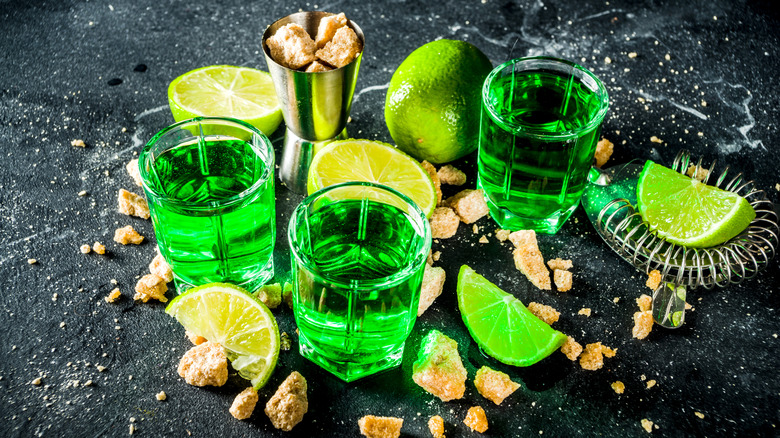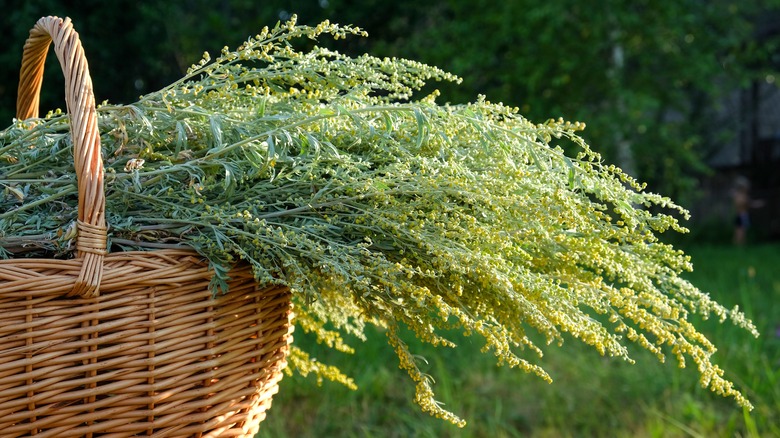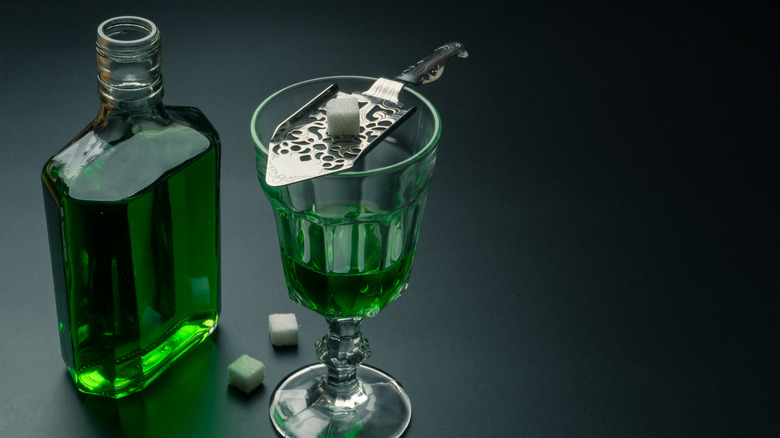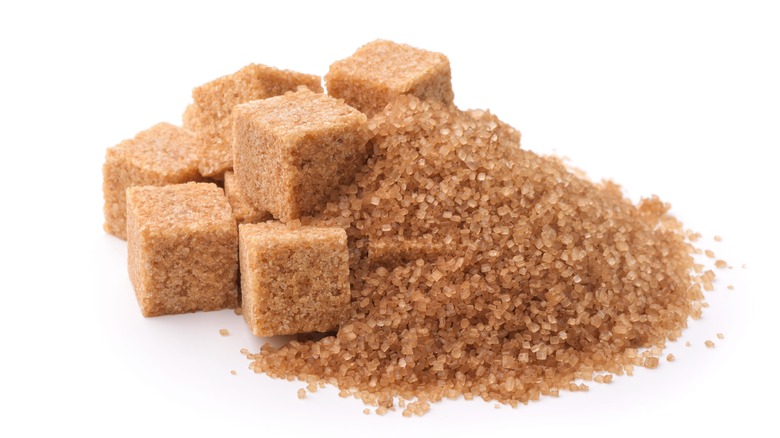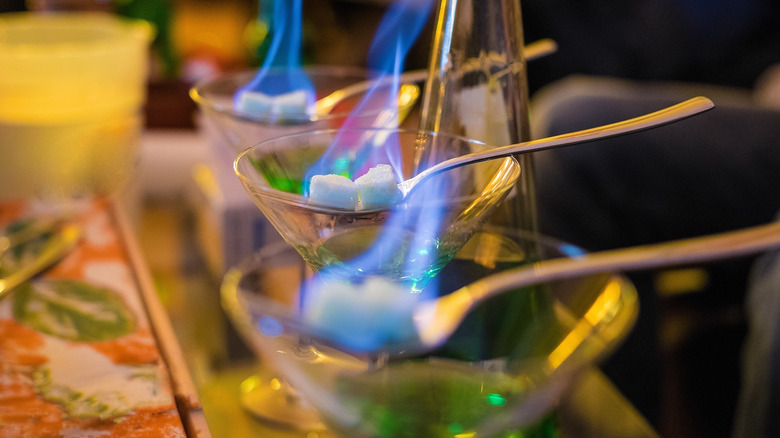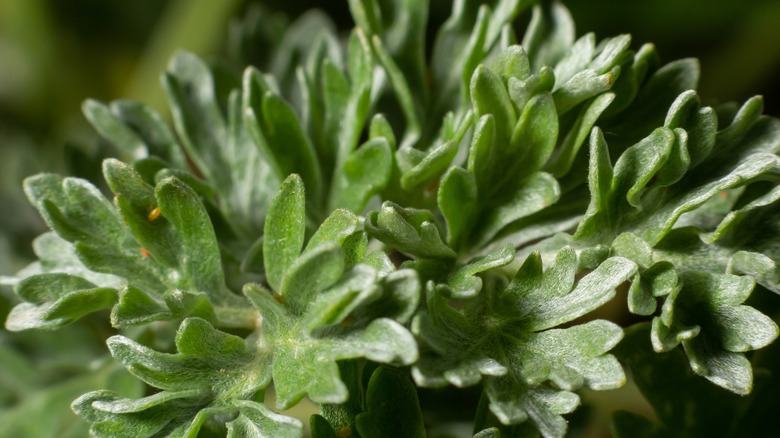Everything You've Ever Needed To Know About Absinthe
The word absinthe probably sounds familiar to you, even if you've never ordered the mysterious drink yourself. Its name is widely recognizable, and not always for the best reasons. Ever since the green drink arrived in Europe from North Africa in the 19th Century, it has been suspected of causing hallucinations and even driving people to commit unspeakable acts. Adored by writers and artists but eventually banned, this beverage — which became known as the green fairy — fell victim to many smear campaigns. Countless false facts have been discredited, but there are still plenty of unfounded question marks hanging over absinthe's reputation.
One of the main ingredients in absinthe is wormwood leaves, which have long been used to treat maladies across the board, from pain to jaundice and more. Even Hippocrates was believed to frequently prescribe this remedy. The medicinal connection can account for many of the rumors and myths tied to absinthe. However, despite the purported benefits, there's more confusion about this drink than possibly any other. So what exactly is the deal with absinthe? How can you drink it? What are the side effects? And is it really dangerous? Here is everything you need to know about the mysterious green drink that's often served alongside fire and sugar.
What's in absinthe and how is it made?
Absinthe is not that big of a mystery if you simply look a little further into how it's made. Similar to gin, the green fairy is merely another flavored liquor that begins with neutral alcohol and can be altered depending on personal preference with a few minor ingredients. Originally, absinthe was made when soldiers who were suffering from ailments began soaking wormwood leaves in their wine. This was one way to consume the wormwood and its health benefits, but also enjoy their wine, which was often bitter or sour. The end result was a serious buzz and a better-tasting beverage.
Of course, the drink has changed over the years. The wormwood initially had a distinct, licorice-type flavor. However, now most absinthe is flavored with anise and fennel in addition to wormwood, resulting in the very distinct flavor that is absinthe. Cinnamon and nutmeg and even lemon balm have also been used to flavor different brands. The unforgettable taste, the high percentage of alcohol, and the vivid green color can probably account for much of the mystery surrounding it. Yet, absinthe is distilled in ways similar to most other liquors. The leaves are soaked in the base alcohol and then distilled in a still that is typically copper. Other methods for making absinthe are also used but are typically considered less effective or as a shortcut to getting a higher percentage.
Why was absinthe banned?
Most of the negativity towards absinthe is down to bad press, rumors, and political motivations. The media and politicians honed in on a few far-fetched theories and ran with them. Soon enough the green fairy became a scapegoat for bad behavior, because blaming the undeniably strong drink was beneficial to their agendas. At the time, absinthe was being tied to some truly horrific stories, so lawmakers took action.
In the early 1900s, absinthe was getting a bad reputation around the world because of the extremely high percentage of alcohol and the behavior that sometimes followed its consumption. Alcohol in general was being held responsible for nearly everything, from tuberculosis and mental health issues to criminal activity. Prior to even the Prohibition, absinthe was banned in Switzerland when a man named Jean Lanfray shot and killed his wife and children after consuming two diluted shots of absinthe. The man claimed that he couldn't explain his actions and later took his own life in prison.
Absinthe was blamed for the tragedy, despite the fact that Lanfray had also consumed copious amounts of wine and brandy. Shortly after the murders, the drink was made illegal in Switzerland. From 1905 to 1912, the green fairy was banned in various other countries. Then, in 1915, France — the modern birthplace of absinthe — also deemed the beverage illegal, and it would remain that way for almost 100 years.
If you or someone you know is struggling or in crisis, help is available. Call or text 988 or chat 988lifeline.org
Can absinthe make you hallucinate?
Absinthe seems to be unable to shake its reputation for making the drinker see things that aren't really there, although the evidence behind this theory is wildly problematic. The connection between the drink and hallucinations stems from rumors such as the aforementioned murders in Switzerland. But how does absinthe differ from other alcohols? The hallucinations have been tied to the compound thujone, which is found in wormwood, yet this explanation falls flat: The amount of wormwood that might eventually cause the consumer to experience hallucinations is far more than what's found in any bottle of absinthe.
The truth is that extremely high-proof alcohols of all types are capable of causing hallucinations; it's not restricted or specific to absinthe. Absinthe is often diluted with water because it is so potent, but gin, whiskey, and vodka can all have the same effect. Seeing and hearing things that are not really there can occur after frequent, excessive, and prolonged use of alcohol or if someone is withdrawing from alcohol abuse. This is an uncommon occurrence, but is most certainly possible.
Known as alcohol hallucinations, they are usually auditory, meaning you might hear voices and other sounds that aren't really there. This condition has been compared to schizophrenia and is more likely to happen when alcohol is mixed with prolonged drug use. It's a very serious condition that can be dangerous for the person experiencing them and others within their vicinity.
If you or anyone you know needs help with addiction issues, help is available. Visit the Substance Abuse and Mental Health Services Administration website or contact SAMHSA's National Helpline at 1-800-662-HELP (4357).
Absinthism explained
The term absinthism was used more frequently back in the 19th century when absinthe was at its peak and the world was pushing back against alcohol consumption in general. It was used to explain the erratic behavior and violence that absinthe apparently caused. The term can really not be differentiated from alcoholism but was often used to build upon the fear surrounding absinthe, helping persuade people to support the Prohibition and other efforts to ban alcohol.
Today, manufacturers and businesses are attempting to manipulate absinthe's previous reputation in order to increase sales. The mysterious risk historically tied to the green fairy has been seized upon by marketing execs now that the drink is legal again. Labels suggest that absinthe is a legal drug or somehow more dangerous than other types of alcohol. Some companies create daring images that paint the drink as barely legal or somehow skirting modern law. The fact is that absinthe's reputation preceded the drink and will likely always have more baggage than others as a result.
The side effects of drinking absinthe
Absinthe was once believed to be directly related to serious side effects and health issues. Hallucinations, acts of violence, madness, seizures, and even death were often linked to absinthe, but any side effects can most likely be credited to the fact that the neutral alcohol that's been flavored is simply an extremely potent form of alcohol. The side effects of any alcohol — and especially high-proof alcohol, such as absinthe — can range from serious to minor. Serious and lasting conditions from prolonged alcohol use such as liver failure, kidney failure, brain damage, and diabetes are all common.
Alcohol can also affect your brain and central nervous system in far less obvious ways, altering your mood and more. Drinking it can feel like a break, but it is actually retraining your brain and how it works, which can lead to increased anxiety, trouble sleeping, poor self-image, drastic mood swings, and other conditions that can lead to an overall sense of anxiety or depression. Absinthe and other high-proof alcohols can trigger these symptoms more quickly because they are so strong, impacting your mood and brain at an extremely rapid pace. Other immediate side effects can be impaired vision, difficulty remembering things, slurred speech, impaired balance, and slow response time.
If you or anyone you know needs help with addiction issues, help is available. Visit the Substance Abuse and Mental Health Services Administration website or contact SAMHSA's National Helpline at 1-800-662-HELP (4357).
Why is absinthe green?
Even if you don't know much about absinthe, you'll probably know that it's green, but what makes it that color, and is it always that color? The neon hue that contributed to the drink's nickname (the green fairy) has been attributed to the chlorophyll from the wormwood leaves and other herbs. The leaves are soaked in the alcohol, distilled, and then often more leaves are added for extra color and flavor. However, most manufacturers now employ artificial coloring to get a consistent, appealing look to every bottle.
Ironically, the green fairy is not always green: Absinthe can be colored using other flowers or botanicals. For example, hibiscus creates a pink or reddish color that is also popular. In addition, the beverage can appear clear if it is not distilled with wormwood or if it utilizes a type of woodworm oil that gives it that distinct anise flavor but not so much of the green color.
What exactly is wormwood?
Some might say that absinthe gets all of its bad reputation from the herb wormwood, as nearly all of the myths can be traced back to the effects and properties of this botanical. However, the plant is actually quite renowned in the medical world. Wormwood is frequently used to create tea and was originally believed to treat stomach issues, such as intestinal worms. The plant is cultivated in the United States nowadays, but it's native to areas in Europe, North Africa, and Western Asia. Wormwood produces pale green leaves along the length of the stem and can also make small yellow flowers that look like sunflowers before they have fully grown.
The medicinal form of wormwood has an extremely long history and dates back many hundreds of years — it was even mentioned in the Bible. It might seem like a positive plant overall, but the thujone component of it can be toxic and dangerous. In large amounts (larger amounts than were present in absinthe even in its early days), thujone is suspected of causing seizures and other health problems. However, the science behind these theories is lacking. To be on the safe side, there are limitations on how much thujone can be present in absinthe as well as other drinks and medicinal treatments.
How to serve absinthe
It is extremely unlikely that absinthe will make you hallucinate or go mad if consumed in small amounts. When this realization came about and bans on alcohol began to slip away, absinthe was put back on the menu and is often served at bars around the world. In fact, the green fairy seems to be gaining popularity again. So the question is, how do you serve absinthe? Here's a hint — it should probably be diluted and sweetened, considering it has a strong and bitter flavor.
Absinthe can have a high alcohol content of over 70%. This means it should be consumed and served responsibly and with extreme caution. However, that doesn't mean it can't be fun. With a history as intriguing and mystical as absinthe's, it deserves a bit of a flourish when it is served. There are, in fact, several ways to serve the green fairy that involve a bit of a ritual. In fact, if you order one and the bartender doesn't look overly happy about it, that's probably because it can be dangerous or downright disastrous if not conducted properly.
The simplest way to serve absinthe is merely watered down. Adding a little cold water can tone down the taste intensity. However, why be simple when you can do the glass in a glass method? This ritual involves placing a shot glass into a larger glass. You first fill the smaller glass with absinthe and then overflow it with water. This is a fancy yet fun way to serve the beverage. The other methods are more involved and require some special tools. Read on to learn about them in more detail.
The French Method
France brought absinthe into the spotlight back in the 1800s. The French soldiers that brought their newfound way of drinking wine home with them from North Africa quickly made it a part of their everyday lives. In fact, at the time that absinthe was first being banned by other countries, France was consuming more alcohol than anywhere else in the world. Therefore, it makes sense that the most common way to serve absinthe — and the most elegant way — can be traced back to the self-styled Country of the Enlightenment.
The French Method requires a glass, a slotted spoon, a sugar cube, cold water, and a shot of absinthe. The process begins with a shot of absinthe at the bottom of the glass. A fancy, flat, and often larger slotted spoon is placed on top of the glass and a sugar cube rests on top. Then, very slowly, cold water is dripped over the sugar and through the spoon. The absinthe slowly releases the parts that dissolve in water and the mixture becomes a light green, cloudy color. Once all of the water is added and the sugar has dissolved, the absinthe is then a diluted, sweeter version of the famous drink. This ritual is meant to be fun and festive, but it also greatly increases the flavor of the drink, bringing out the many subtle hints of anise and fennel.
The Bohemian Method
Another method of serving absinthe, the Bohemian Method is more dangerous. Also known as the Contemporary Czech Flaming Method, this is probably what's happening if you're at the bar and you see a sugar cube on fire on top of a glass of green liquid. This method is very similar to the French method — but with some extra heat. The Bohemian Method requires the same tools. Begin with an empty glass and place the spoon with the sugar cube on top. You will pour the absinthe over the sugar cube, through the slotted spoon. This will soak the sugar in alcohol, which can then be very carefully lit on fire. The heat will caramelize and melt the sugar, which creates an even more interesting flavor when mixed with the absinthe.
With this method, you must be careful not to spill the absinthe as it can catch on fire, and do not try to burn the sugar if it hasn't been soaked, as this will cause it to burn. The sugar will take a few minutes to melt. From there you can stir the remaining sugar into the absinthe and make sure it dissolves. Then add your water to dilute the drink. This is another fun ritual that makes absinthe more exciting than your bog standard spirit. There are also specialized, beautiful glasses and slotted spoons designed for serving absinthe, if you want even more flare.
Making absinthe at home
Just like other beverages and rituals, there are ways to make absinthe in the comfort of your own home. You can cut costs, get adventurous, and make a fun, entertaining night for you and your friends if you serve homemade absinthe or make it together.
The best thing about absinthe is that the first step is beyond easy. Whether you're making absinthe at home or manufacturers are distilling it in a warehouse, you begin with already distilled neutral liquor, such as vodka. The process from there is also pretty similar to the methods that some manufacturers use, which is basically soaking the wormwood and the other spices and herbs in the alcohol for a few days. Most absinthe is a recipe of wormwood, fennel, and anise, but there are plenty of opportunities to add your own spin with ingredients such as coriander and cardamom.
After allowing the mixture to sit for anywhere from two weeks to two months you can strain the liquid and distill the mixture on the stove to cook down some of the alcohol. From that point, you can experiment with your mixture and herbs to create your desired flavor. Just remember that absinthe is a very strong drink and should not be consumed regularly — it's best kept for special occasions.
